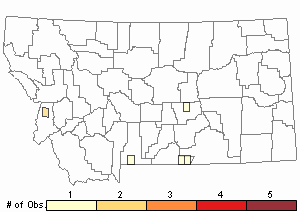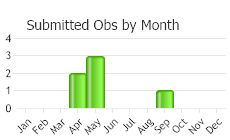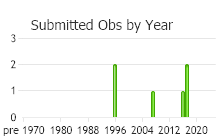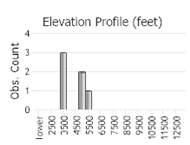View in other NatureServe Network Field Guides
NatureServe
Montana
Utah
Wyoming
Idaho
Wisconsin
British Columbia
South Carolina
Yukon
California
New York
Sessile Pterygoneurum Moss - Pterygoneurum subsessile
State Rank Reason (see State Rank above)
Had been ranked SU and given Distribution Confidence in BIOTICS as "Reported but unconfirmed", but not updated since 4/5/2000. Changed rank temporarily to SNR (pending review) and distribution as Present.
General Description
Plants: Acrocarpous. Growing in crowded clumps of erect shoots (Crum & Anderson et al., 1981), greyish-green (Flowers 1973), with numerous rhizoids below. Stems partially covered in soil (FNA 2007), to about 5 mm in height (Crum & Anderson et al., 1981), possessing a central strand and without a hyalodermis; axillary hairs present (FNA 2007).
Leaves: Stem leaves flat and overlapping when dry, spreading a little when wet, egg-shaped (FNA 2007) to oblong (Lawton 1971), suddenly constricting to the long awn (Crum & Anderson et al., 1981), 0.8-1.8 mm in length (not including the awn) (Lawton 1971), widely cupped ventrally; leaf edges smooth or finely toothed above, flat below, curved up and inward above, sometimes faintly so; leaf tip somewhat widely angled, sometimes rounded, frequently faintly cucullate; costa occasionally missing, otherwise extending well beyond the leaf tip to form an awn, with lamellae running longitudinally from the ventral costal surface (differentiated from the superficial ventral cells); lamellae usually 3-4 (FNA 2007) distally (Lawton 1971), seldom none; awn toothed or finely saw-toothed (FNA 2007); 0.4-4.8 mm in length (Lawton 1971), similar in length to the base to twice as long (Crum & Anderson et al., 1981), hyaline (Flowers 1973).
Leaf Cells: Lower laminal cells distinct across the bottom of the leaf, quadrangular, mostly 2-5:1, slightly swollen, fine-walled; upper medial cells square to short and quadrangular, frequently elongated crosswise to the leaf, 1 cell-layer thick; costa in X-section with 2 guide cells in 1 series, a small dorsal stereid band, and a dorsal superficial layer of cells; lamellae 10-12 cells tall (FNA 2007), tallest at the distal end, becoming shorter toward the base (Flowers 1973); cells of the lamellae chlorophyllous, with filaments occasionally extending from some of them (FNA 2007).
Pterygoneurum subsessile var. subsessile: Present in Montana; and Pterygoneurum subsessile var. kieneri (FNA 2007).
Phenology
Variety subsessile: Fruit ripens the last part of winter into spring (FNA 2007).
Variety kieneri: Fruit ripens in mid-summer (FNA 2007).
Range Comments
North American Range
Variety subsessile: AK, YT, BC to SK, OR to WY and extending s to CA, AZ and NM, ND s to TX, MN and IA, IL (FNA 2007). Known in Montana from Cascade and Ravalli Counties (Elliott & Pipp, 2016).
Variety kieneri: Known only from Chase County, NE (FNA 2007).
Observations in Montana Natural Heritage Program Database
Number of Observations: 6
(Click on the following maps and charts to see full sized version)
Map Help and Descriptions
Relative Density

Recency



 (Observations spanning multiple months or years are excluded from time charts)
(Observations spanning multiple months or years are excluded from time charts)
Habitat
Variety subsessile: Volcanic, saline or sandy soil (FNA 2007). Elevation: 1970-5580 feet (FNA 2007).
Variety kieneri: Soil in grasslands. Elevation around 3110 feet (FNA 2007).
Reproductive Characteristics
Autoicous, sometimes with antheridia situated close to but not mingling with the archegonia. Perichaetia similar to stem leaves, not enveloping the stem (FNA 2007). Seta 0.3-1 mm in height (Lawton 1971), not bearing the capsule beyond the perichaetial leaves or only partially so (FNA 2007). Capsule brown to deep brown, wrinkled when dry (Crum & Anderson et al., 1981), 0.5-0.85 mm in length; operculum beaked, about 0.7 mm in length (Lawton 1971), with cell rows straight; peristome absent. Calyptra conical (FNA 2007).
Variety subsessile: Opening by means of the operculum falling away (FNA 2007).
Variety kieneri: Capsule exploding erratically (FNA 2007).
Stewardship Responsibility
References
- Literature Cited AboveLegend:
 View Online Publication
View Online Publication Crum, H.A. and L.E. Anderson. 1981. Mosses of Eastern North America. 2 volumes. Columbia University Press, New York. 1328 pp.
Crum, H.A. and L.E. Anderson. 1981. Mosses of Eastern North America. 2 volumes. Columbia University Press, New York. 1328 pp. Elliott, J.C. and A.K. Pipp. 2018. A Checklist of Montana Mosses (1880-2018). Updated 3 January, 2020. Montana Natural Heritage Program, Helena, Montana. 73 pp.
Elliott, J.C. and A.K. Pipp. 2018. A Checklist of Montana Mosses (1880-2018). Updated 3 January, 2020. Montana Natural Heritage Program, Helena, Montana. 73 pp. Flora of North America Editorial Committee, eds. 2007. Flora of North America North of Mexico. Volume 27. Bryophytes: Mosses, Part 1. Oxford University Press, Inc., NY. xxi + 713 pp.
Flora of North America Editorial Committee, eds. 2007. Flora of North America North of Mexico. Volume 27. Bryophytes: Mosses, Part 1. Oxford University Press, Inc., NY. xxi + 713 pp. Flowers, S. 1973. Mosses: Utah and the West. Brigham Young University, Provo, Utah. 567 p.
Flowers, S. 1973. Mosses: Utah and the West. Brigham Young University, Provo, Utah. 567 p. Lawton, E. 1971. Moss Flora of the Pacific Northwest. Hattori Botanical Laboratory. Japan: Yamabuki-cho, Shinjuku-ku, Tokyo. 362 pages plus appendices.
Lawton, E. 1971. Moss Flora of the Pacific Northwest. Hattori Botanical Laboratory. Japan: Yamabuki-cho, Shinjuku-ku, Tokyo. 362 pages plus appendices.
- Additional ReferencesLegend:
 View Online Publication
View Online Publication
Do you know of a citation we're missing? Elliot, J. C. 1993. Second checklist of Montana mosses. Unpublished report. U.S. Forest Service, Region 1. Missoula, MT. 45 pp.
Elliot, J. C. 1993. Second checklist of Montana mosses. Unpublished report. U.S. Forest Service, Region 1. Missoula, MT. 45 pp. Lawton, E. 1971. Keys for the Identification of the Mosses on the Pacific Northwest. Reprinted from 'Moss Flora of the Pacific Northwest'. Published as Supplement No. 2 of the Journal of the Hattori Botanical Laboratory. Nichinan, Miyazaki, Japan. 66 pp.
Lawton, E. 1971. Keys for the Identification of the Mosses on the Pacific Northwest. Reprinted from 'Moss Flora of the Pacific Northwest'. Published as Supplement No. 2 of the Journal of the Hattori Botanical Laboratory. Nichinan, Miyazaki, Japan. 66 pp. Malcolm, B., N. Malcolm, J. Shevock, and D. Norris. 2009. California Mosses. Nelson, New Zealand: Micro-Optics Press. 430 pp.
Malcolm, B., N. Malcolm, J. Shevock, and D. Norris. 2009. California Mosses. Nelson, New Zealand: Micro-Optics Press. 430 pp.
- Web Search Engines for Articles on "Sessile Pterygoneurum Moss"





